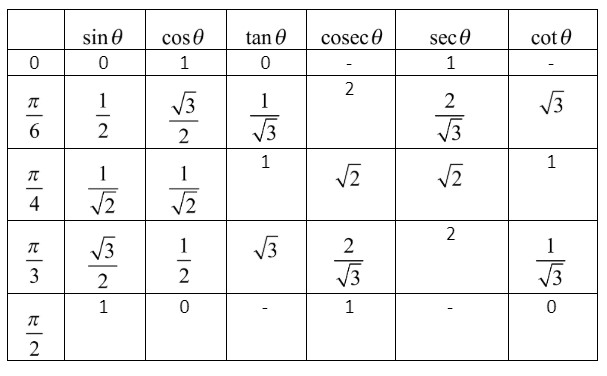Question
Question: Evaluate the following \[{{\tan }^{-1}}\left( -\dfrac{1}{\sqrt{3}} \right)+{{\tan }^{-1}}\left( -\...
Evaluate the following
tan−1(−31)+tan−1(−3)+tan−1(sin(−2π))
Solution
Hint:First of all, use sin(−θ)=−sinθ. Now use, tan−1(−x)=−tan−1x in each term. Now find the angles at which tanθ=31,tanθ=3 and tanθ=1 or the value of tan−1(31),tan−1(3) and tan−1(1) and substitute these in the given expression to get the required answer.
Complete step-by-step answer:
In this question, we have to find the value of the expression tan−1(−31)+tan−1(−3)+tan−1(sin(−2π)).
First of all, let us consider the expression given in the question,
E=tan−1(−31)+tan−1(−3)+tan−1(sin(−2π))
We know that sin(−θ)=−sinθ. By using this in the above expression, we get,
E=tan−1(−31)+tan−1(−3)+tan−1(−sin2π)
Also, we know that, tan−1(−x)=−tan−1x. By using this in the above expression, we get,
E=−tan−1(31)+(−tan−13)+tan−1(−sin2π)
E=−tan−1(31)−tan−13−tan−1(sin2π).....(i)
Now, let us draw the table for trigonometric ratios of general angles.

From the above table, we get, sin2π=1. By using this in equation (i), we get,
E=−tan−1(31)−tan−13−tan−1(1).....(ii)
Also from the above table, we can see that
tan(6π)=31
⇒tan−1(31)=6π
tan(3π)=3
⇒tan−1(3)=3π
tan(4π)=1
⇒tan−1(1)=4π
So by substituting the value of tan−1(31),tan−1(3) and tan−1(1) in equation (ii), we get, E=−6π−3π−4π
By simplifying the above equation, we get,
E=−(6π+3π+4π)
E=12−(2π+4π+3π)
E=−(129π)
E=4−3π
Hence, we get the value of tan−1(−31)+tan−1(−3)+tan−1(sin(−2π)) as 4−3π.
Note: In this question, some students make this mistake of taking tan−1(−x) as π−tan−1(x) like in case of cot−1(−x) which is wrong because tan−1(−x)=−tan−1(x). Also in the case of inverse trigonometric functions, students must take care that the angle they take must lie in the range of respective functions to get the correct answer. Also, students should memorize the table for general trigonometric ratios.
